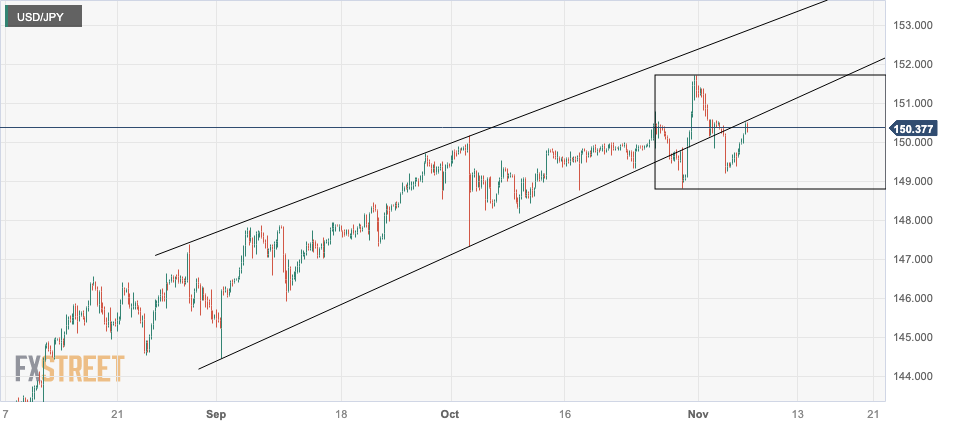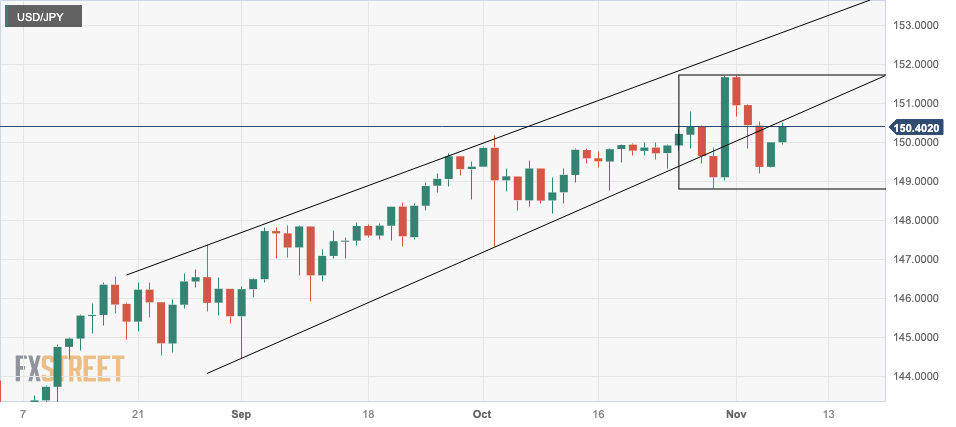Japanese Yen continues weakening against US Dollar on Kashkari's hawkish comment
- The Japanese Yen falls against a stronger US Dollar on Tuesday.
- USD outperforms JPY after hawkish commentary from Fed President Kashkari.
- Indecision over direction of interest rates in both US and Japan is reflected in USD/JPY’s range bound yo-yo-ing.
The Japanese Yen (JPY) has continued to slide against the US Dollar (USD) for the second straight day this week after Minneapolis Federal Reserve President Neel Kashkari said the US Federal Reserve (Fed) might not be finished with its hiking cycle. His comments helped lift the US Dollar. The USD/JPY pair traded up to 150.54 at the time of writing, up 47 pips on the day.
Daily digest market movers: Yen falls on Fed uncertainty
- The Yen continues falling against the US Dollar after an article in the Wall Street Journal on Monday quoted Fed’s Kashkari as saying more work needed to be done to bring down inflation.
- His view goes against the grain. The widespread market opinion is that the Fed is done with raising interest rates.
- In contrast, comments from Federal Reserve Governor Lisa Cook on the same day suggested the Fed would not be rushing to hike interest rates.
- Cook argued the rise in longer-term US Treasury yields was not a result of investors pricing in a belief that the Fed would continue raising interest rates, according to Reuters.
- By suggesting the rise in yields was not driven by investor expectations, Cook implied there was no pressure on the Fed to follow through – thus, her comments were taken as dovish.
- The BoJ also gave mixed signals at its last policy meeting: whilst the board of governors made a step towards normalizing policy by relaxing the 1.0% artificial cap it had imposed on 10-year Japanese Government Bond (JGB) yields – essentially a form of quantitative easing – Bank of Japan Governor Kazuo Ueda played down expectations of rate hikes.
- In fact, Governor Ueda stated that most of the inflation in Japan was from higher commodity prices rather than increased demand, suggesting the BoJ would need to continue to keep monetary policy accommodative to support the economy.
- Further, according to Reuters, despite saying it had softened the yield cap, the BoJ actually intervened to defend it on October 31, suggesting the bank’s actions don’t match its words and de facto easing is still in place.
- "Ueda signaled that the prospect of negative rates being reversed this year was very low,” said James Harte, analyst at Tickmill Group, in a note, reported by Barron’s.
- Japanese data out on Monday evening continued to paint a picture of a tight economy not advantageous to the Yen.
- Labour Cash Earnings for September rose by 1.2% YoY, which was above the 1.0% forecast, and 1.1% previous.
- However, Household Spending in the same month showed a deeper-than-expected 2.8% contraction versus the -2.7% change YoY estimated and -2.5% previous.
- The next key event for the pair is Jerome Powell’s speech at 13:15 on November 8.
Japanese Yen technical analysis: USD/JPY climbs back up to kiss the channel line
USD/JPY – the number of Yen that one Dollar buys – continues higher on Tuesday. The recovery means the short-term trend is starting to look range bound, with price sandwiched between the 151.70 highs of October 30 and the key 148.80 lows. As such it will probably continue yo-yoing until a break through on either side confirms directionality.

US Dollar vs Japanese Yen: 4-hour Chart
During Tuesday’s action, the pair has returned to the lower channel line of the rising channel it has been in since the summer. It is now meeting resistance at the channel line where it once met support. There are no signs of a reversal back down yet however.

US Dollar vs Japanese Yen: Daily Chart
On the daily chart used to assess the medium-term outlook, the pair is still in an uptrend. On this chart too, the 148.80 low holds the key. Ultimately, as the saying goes, the “trend is your friend” and as long as 148.80 remains intact the medium-term trend remains firmly bullish.
If the 151.93 level from October 2022 – which marked a 32-year-high – is breached, the uptrend will gain reconfirmation, with next targets expected to be met at the round numbers – 153.00, 154.00, 155.00 etc.
Japanese Yen FAQs
What key factors drive the Japanese Yen?
The Japanese Yen (JPY) is one of the world’s most traded currencies. Its value is broadly determined by the performance of the Japanese economy, but more specifically by the Bank of Japan’s policy, the differential between Japanese and US bond yields, or risk sentiment among traders, among other factors.
How do the decisions of the Bank of Japan impact the Japanese Yen?
One of the Bank of Japan’s mandates is currency control, so its moves are key for the Yen. The BoJ has directly intervened in currency markets sometimes, generally to lower the value of the Yen, although it refrains from doing it often due to political concerns of its main trading partners. The current BoJ ultra-loose monetary policy, based on massive stimulus to the economy, has caused the Yen to depreciate against its main currency peers. This process has exacerbated more recently due to an increasing policy divergence between the Bank of Japan and other main central banks, which have opted to increase interest rates sharply to fight decades-high levels of inflation.
How does the differential between Japanese and US bond yields impact the Japanese Yen?
The BoJ’s stance of sticking to ultra-loose monetary policy has led to a widening policy divergence with other central banks, particularly with the US Federal Reserve. This supports a widening of the differential between the 10-year US and Japanese bonds, which favors the US Dollar against the Japanese Yen.
How does broader risk sentiment impact the Japanese Yen?
The Japanese Yen is often seen as a safe-haven investment. This means that in times of market stress, investors are more likely to put their money in the Japanese currency due to its supposed reliability and stability. Turbulent times are likely to strengthen the Yen’s value against other currencies seen as more risky to invest in.